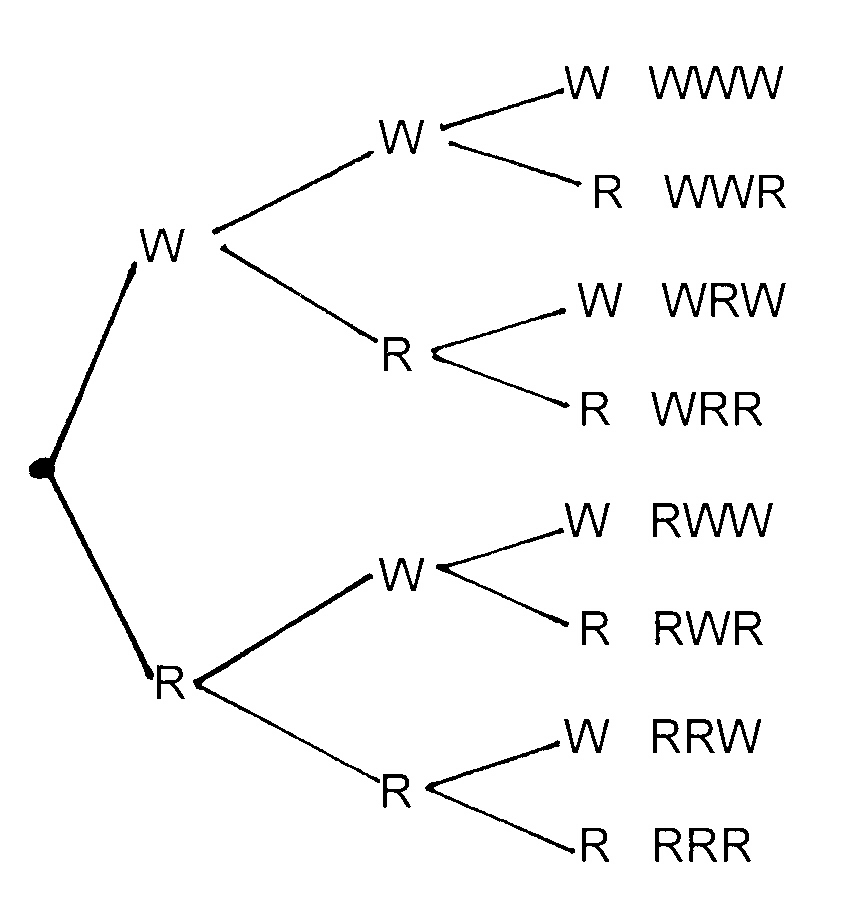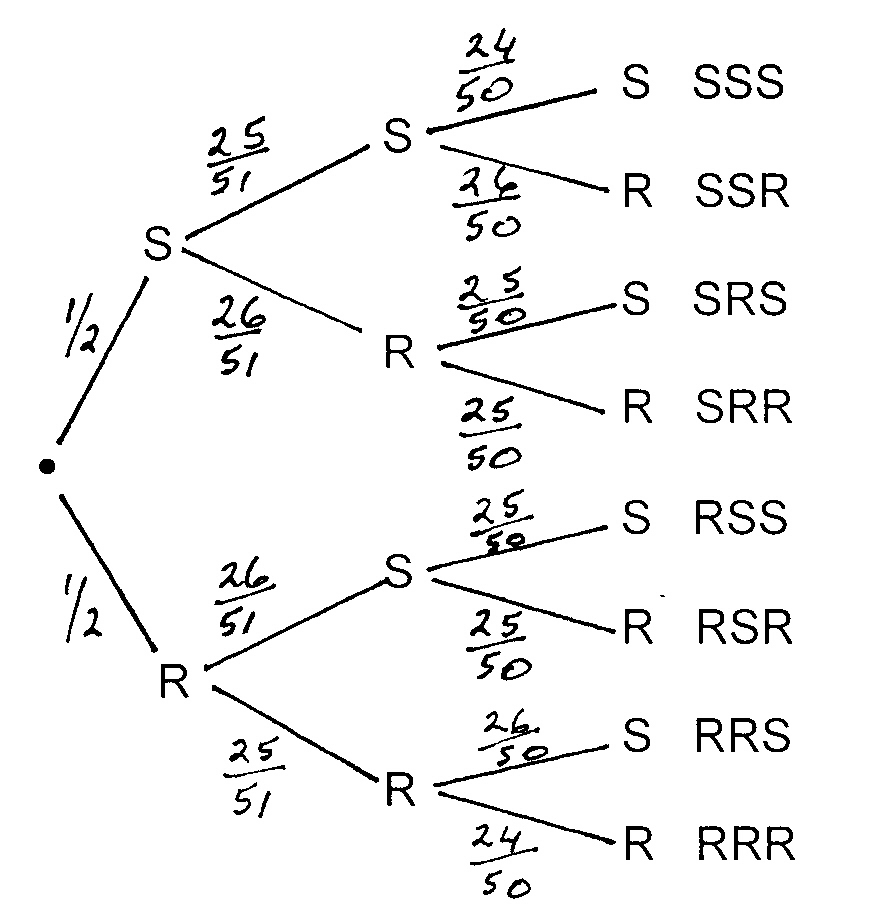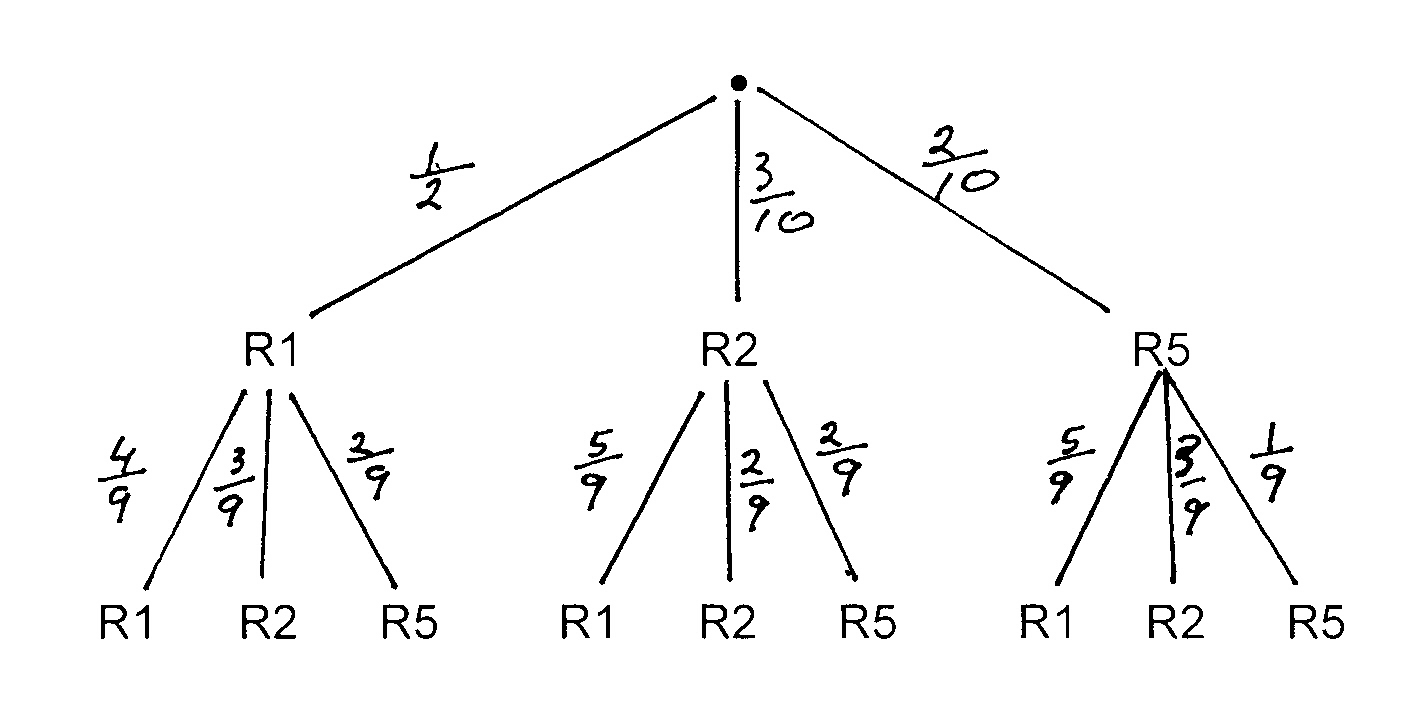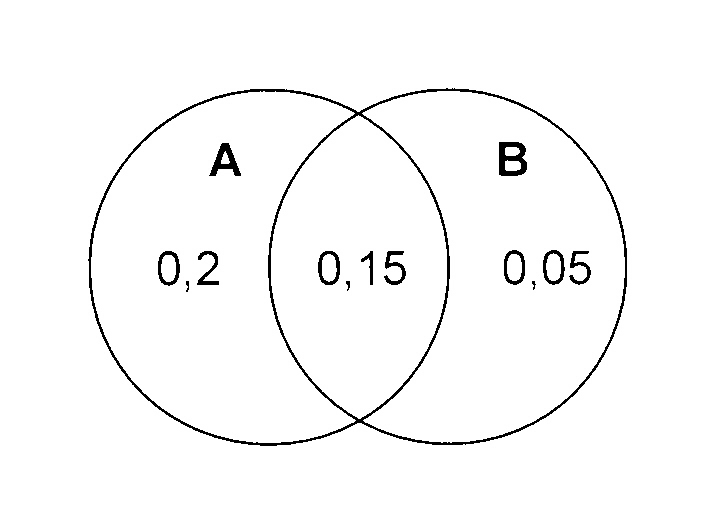WISKUNDE
GRAAD 10
NOG OEFENINGE
Waarskynlikheid : antwoorde.
GRAAD 10
NOG OEFENINGE
Waarskynlikheid : antwoorde.
MATHEMATICS
GRADE 10
MORE EXERCISES
Probability : answers.
GRADE 10
MORE EXERCISES
Probability : answers.
1.1 43 seuns speel krieket. 43 boys play cricket.
16 + 6 + x + 10 = 43
x = 43 − 32
x = 11
11 seuns neem aan al drie sportsoorte deel. /
11 boys participate in al three games.
16 + 6 + x + 10 = 43
x = 43 − 32
x = 11
11 seuns neem aan al drie sportsoorte deel. /
11 boys participate in al three games.
1.2 Daar is 100 seuns. There are 100 boys.
43 + 25 + 12 + 12 + y = 100
y = 100 − 92
y = 8
8 seuns neem nie aan sport deel nie. /
8 boys do not participate in any game.
43 + 25 + 12 + 12 + y = 100
y = 100 − 92
y = 8
8 seuns neem nie aan sport deel nie. /
8 boys do not participate in any game.
8
54
1.3.1
P(geen/no sport) = ─── = 0,08
1.3.2
P(S) = ─── = 0,54
100
100
16
16 + 25 + 12
1.3.3
P(net/only C) = ─── = 0,16
1.3.4
P(net /only 1) = ──────── = 0,53
100
100
6 + 10 + 12
11
1.3.5
P(2 soorte/2 games) = ──────── = 0,28
1.3.6
P(al/all 3) = ─── = 0,11
100
100
10 + 12
16 + 6 + 25 + 8
1.3.7
P(T ∩ S') = ───── = 0,22
1.3.8
P(T') = ─────────── = 0,55
100
100
16 + 6 + 25
45
1.3.9
P(C ∩ S ∩ T') = ──────── = 0,47
OF / OR P(T') = 1 − P(T) = ─── = 0,55
100
100
2.1 A bevat 40 elemente. A contains 40 elements.
13 + 8 + x + 7 = 40
x = 40 − 28
x = 12
13 + 8 + x + 7 = 40
x = 40 − 28
x = 12
2.2 B bevat 30 elemente. B contains 30 elements.
8 + 6 + y + 12 = 30
y = 30 − 26
y = 4
C bevat 43 elemente. C contains 43 elements.
7 + 12 + 4 + z = 43
z = 43 − 23
z = 20
Totale aantal elemente = 40 + 6 + 4 + 20 = 70
Total number of elements = 40 + 6 + 4 + 20 = 70
8 + 6 + y + 12 = 30
y = 30 − 26
y = 4
C bevat 43 elemente. C contains 43 elements.
7 + 12 + 4 + z = 43
z = 43 − 23
z = 20
Totale aantal elemente = 40 + 6 + 4 + 20 = 70
Total number of elements = 40 + 6 + 4 + 20 = 70
40
4
40 + 4 + 20
32
2.3.1
P(A) = ─── = ──
2.3.2
P(A ∪ C) = ───────── = ──
70
7
70
35
13 + 7 + 20
4
12
6
2.3.3
P(B') = ──────── = ──
2.3.4
P(A ∩ B ∩ C) = ─── = ──
70
7
70
35
8 + 12
2
8 + 6
1
2.3.5
P(A ∩ B) = ───── = ──
2.3.6
P(B ∩ C') = ──── = ──
70
7
70
5
20 + 10 + 20
5
13
2.3.7
P((A ∩ B)') = ───────── = ──
2.3.8
P(B ∪ C)' = ───
70
7
70
6
3
2.3.9
P(net / only B) = ── = ──
OF / OR
70
35
13
P(B ∪ C)' = 1 − P(B ∪ C) = ──
70
x + 21
3.1
P(B ∩ C) = ───── = 0,17
3.2
n(A) = 53 + 28 + 21 + 10 = 112
200
x + 21 = 34
n(B) = 28 + 30 + 13 + 21 = 92
x = 13
n(C) = 10 + 21 + 13 + 45 = 89
112
92
3.3.1
P(A) = ─── = 0,560
3.3.2
P(B) = ──── = 0,460
200
200
53 + 28 + 30
112 + 30 + 13
3.3.3
P(C') = ───────── = 0,555
3.3.4
P(A ∪ B) = ───────── = 0,775
200
200
OF / OR
OF / OR
P(C') = 1 − P(C)
P(A ∪ B) = P(A) + P(B) − P(A ∪ B)
89
112
92
49
= 1 − ─── = 0,555
= ─── + ─── − ─── = 0,775
200
200
200
200
6
2
4
4.1
P(A) = ─── = ──
4.2
P(C) = ──
15
5
15
9
3
2
4.3
P(B') = ─── = ──
4.4
P(A ∩ B) = ──
15
5
15
9
3
4.5
P(B ∪ C) = ─── = ──
4.6
P(A ∩ C) = 0
15
5
2
3
1
4.7
P(A ∪ B ∪ C)' = ───
4.8
P(A' ∩ B ∩ C') = ── = ──
15
15
5
1
5.2.1
P(3W) = ──
5.1

8
OF/OR Die waarskynlikheid om 'n wit of rooi
te kry, bly 0,5.
The probability to get a white or red
remains 0,5.
1
1
1
1
∴ P(3W) = ── × ── × ── = ──
2
2
2
8
5.2.2
P(net 1W/ only 1W) : {WRR, RWR, RRW}
3
P(net 1W/ only 1W) = ──
8
5.2.3
P(minstens 1R/ at least 1R) :
{WWR, WRW, WRR, RWW, RWR, RRW, RRR}
7
P(minstens 1R/ at least 1R) = ──
8
5.2.4
P(twee of meer wit / two or more white) : {WWW, WWR, WRW, RWW}
4
1
P(twee of meer wit / two or more white) = ── = ──
8
2
6.1

6.2.1
P(2S en/and 1R) : {SSR, SRS, RSS}
1
25
26
1
26
25
1
26
25
13
P(2S, 1R) = ─── × ─── × ─── + ─── × ─── × ─── + ─── × ─── × ─── = ───
2
51
50
2
51
50
2
51
50
34
6.2.2
P(geen R/no R) : {SSS}
1
25
24
2
P(3S, 0R) = ─── × ─── × ─── = ──
2
51
50
17
6.2.3
P(2S en 1R/2s and 1R) : {SSR}
1
25
26
13
P(2S, 1R) = ─── × ─── × ─── = ───
2
51
50
102
6.2.4
P(2 of meer R/2 or more R) : {SRR, RSR, RRS, RRR}
1
26
25
1
26
25
1
25
26
1
25
24
P(2S, 1R) = ─── × ─── × ─── + ─── × ─── × ─── + ─── × ─── × ─── + ─── × ─── × ───
2
51
50
2
51
50
2
51
50
2
51
50
1
= ───
2
1
x
1
7.1
P(R1) = ── ∴ ── = ── en dus / so that x = 5
2
10
2
7.2

7.3.1
P(2 R5) : {R5R5}
7.3.2
P(R2 en/and R1) : {R1R2, R2R1}
2
1
1
1
3
3
5
1
P(2 R5) = ── × ── = ──
P(R2 & R1) = ── × ── + ── × ── = ──
10
9
45
2
9
10
9
3
7.3.3
P(2 R5) : {R5R5}
3
2
1
P(R2 & R5) = ── × ── = ──
10
9
15
8.1
a = 34 + 36 = 70
b = 102 − 44 = 58
c = 70 − 38 = 32
d = 250 − 11 = 140
8.2
Gebeurtenis A : "Leerling is 'n dogter"
8.3
Gebeurtenis A : "Dogters"
Gebeurtenis B : "Verkies program S"
Gebeurtenis B : "Verkies program S"
Event A : "Pupil is a girl"
Event A : "Girls"
Event B : "Programme S is preferred"
Event B : "Programme S is preferred"
A en B is onderling uitsluitend as
A en B is onafhanklik as
P(A of B) = P(A) + P(B), d.w.s. as P(A ∩ B) = 0
P(A ∩ B) = P(A) × P(B)
A and B are mutually exclusive if
A and B are independent if
P(A or B) = P(A) + P(B), i.e. if P(A ∩ B) = 0
P(A ∩ B) = P(A) × P(B)
58
140
P(A ∩ B) = ─── ≠ 0
P(A) = ──── = 0,56
250
250
102
A en B nie onderling uitsluitend nie.
P(B) = ──── = 0,41
250
A and B not mutually exclusive.
58
P(A ∩ B) = ──── = 0,23
250
110
8.4.1
P(seun / boy) = ─── = 0,44
250
P(A) × P(B) = 0,56 × 0,41 = 0,23 = P(A ∩ B)
34
8.4.2
P(seun ∩ R / boy ∩ R) = ─── = 0,136
250
∴ A en B is onafhanklik.
∴ A and B are independent.
70
38
8.4.3
P(T) = ─── = 0,280
8.4.4
P(dogter ∩ T / girl ∩ T) = ─── = 0,152
250
250
9.1
9 + b = 25
25 + 60 + c = 100
b = 16
c = 15
a + 12 = 15
d + 70 = 100
a = 3
d = 30
9.2
Gebeurtenis A : "Werknemer is 'n man"
9.3
Gebeurtenis A : "Werknemer is 'n vrou"
Gebeurtenis B : "Hoogste kwalifikasie 'n"
Gebeurtenis B : "Hoogste kwalifikasie"
Senior Sertifikaat"
'n Diploma"
Event A : "Employee is a man"
Event A : "Employee is a lady"
Event B : "Highest qualification is a
Event B : "Highest qualification is a Diploma"
Senior Certificate"
A en B is onderling uitsluitend as
A en B is onafhanklik as
P(A of B) = P(A) + P(B), d.w.s. as P(A ∩ B) = 0
P(A ∩ B) = P(A) × P(B)
A and B are mutually exclusive if
A and B are independent if
P(A or B) = P(A) + P(B), i.e. if P(A ∩ B) = 0
P(A ∩ B) = P(A) × P(B)
9
70
62
P(A ∩ B) = ─── ≠ 0
P(A) × P(B) = ─── × ─── = 0,434
100
100
100
A en B is nie onderling uitsluitend nie.
42
P(A ∩ B) = ─── = 0,42
100
A and B are not mutually exclusive.
P(A ∩ B) ≠ P(A) × P(B)
25 + 60
9.4.1
A en B is nie onafhanklik nie.
P(geen graad / no degree) = ────── = 0,85
100
A and B are not independent.
OF / OR
25
P(graad' / degree') = 1 − P(graad / degree)
9.4.2
P(net SS / only SC) = ─── = 0,25
100
15
= 1 − ─── = 0,85
100
16
3
9.4.3
P(V ∩ SS / F ∩ SC)A = ──── = 0,16
9.4.4
P(M ∩ G / M ∩ D) = ──── = 0,03
100
100
10.1
a + 12 = 20
b = 6 + 22
a = 8
= 28
12 + c = 26
d + 50 = 80
c = 14
d = 30
10.2
Gebeurtenis A : "Manlik M"
10.3
Gebeurtenis A : "Vroulik"
Gebeurtenis B : "Verkies skapvleis SM"
Gebeurtenis B : "Verkies hoender HC"
Event A : "Male M"
Event A : "Female L"
Event B : "Prefers mutton SM
Event B : "Prefers chicken HC"
A en B is onderling uitsluitend as
A en B is onafhanklik as
P(A of B) = P(A) + P(B), d.w.s. as P(A ∩ B) = 0
P(A ∩ B) = P(A) × P(B)
A and B are mutually exclusive if
A and B are independent if
P(A or B) = P(A) + P(B), i.e. if P(A ∩ B) = 0
P(A ∩ B) = P(A) × P(B)
8
50
28
P(A ∩ B) = ─── ≠ 0
P(A) × P(B) = ─── × ─── = 0,21875
80
80
80
A en B is nie onderling uitsluitend nie.
22
P(A ∩ B) = ─── = 0,275
100
A and B are not mutually exclusive.
P(A ∩ B) ≠ P(A) × P(B)
30
10.4.1
A en B is nie onafhanklik nie.
P(M) = ─── = 0,38
80
A and B are not independent.
25
10.4.2
P(VP) = ─── = 0,08
80
16
26
10.4.3
P(L ∩ SM)A = ─── = 0,20
10.4.4
P(B') = 1 − P(B) = 1 − ─── = 0,68
80
80
11.
A en B is onderling uitsluitend.
A and B are mutually exclusive.
∴ P(A of / or B) = P(A) + P(B)
11.1
P(A of / or B) = P(A) + P(B)
11.2
P(A of / or B) = P(A) + P(B)
P(A of / or B) = 0,17 + 0,23
0,6 = P(A) + 0,37
= 0,40
P(A) = 0,6 − 0,37
= 0,23
12.
A en B is onafhanklik.
A and B are independent.
∴ P(A en / and B) = P(A) × P(B)
12.1
P(A en / and B) = P(A) × P(B)
12.2
P(A en / and B) = P(A) × P(B)
P(A en / and B) = 0,13 × 0,25
0,06 = 0,2 × P(B)
= 0,0325
P(B) = 0,06 ÷ 0,2
= 0,3
13.1
P(A of / or B) = P(A) + P(B) − P(A en / and B)
13.2
P(A) × P(B) = 0,45 × 0,34
0,55 = 0,45 + 0,35 − P(A en / and B)
= 0,153
P(A en / and B) = 0,45 + 0,35 − 0,55
≠ 0,25 [P(A ∩ B)]
= 0,25
A en B is nie onafhanklik nie.
A en B are not independent.
13.3
P(A ∩ B) = 0,25 ≠ 0
A en B is nie onderling uitsluitend nie. / A and B are not mutually exclusive.
14.1
P(A ∩ B) = 0,12 ≠ 0
14.2
P(A) × P(B) = 0,3 × 0,4
A en B is nie onderling uitsluitend nie.
= 0,12 = P(A ∩ B)
A and B are not mutually exclusive.
A en / and B is onafhanklik / are independent.
14.3
P(A of / or B) = P(A) + P(B) − P(A en / and B)
= 0,3 + 0,4 − 0,12
= 0,58
15.1
P(A of/or B) = P(A) + P(B) − P(A en/and B)
15.2
A en B onderling uitsluitend as P(A en B) = 0.
0,7 = 0,4 + 0,5 − P(A en/and B)
A and B are mutually exclusive if
P(A en/and B) = 0,4 + 0,5 − 0,7
P(A and B) = 0.
= 0,2
P(A en/and B) = 0,2 ≠ 0 en dus / and therefore
A en B nie onderling uitsluitend nie.
A and B are not mutually exclusive.
15.3
As P(A) × P(B) = P(A en B), dan is
If P(A) × P(B) = P(A and B), then
A en B onafhanklik.
A and B are independent.
P(A) × P(B) = 0,4 × 0,5
= 0,2 = P(A en/and B)
A en B is onafhanklik.
A and B are independent.
16.1
P(A of/or B) = P(A) + P(B) − P(A en/and B)
16.2
P(A') = 1− P(A)
0,4 = 0,35 + 0,2 − P(A en/and B)
= 1− 0,35
P(A en/and B) = 0,35 + 0,2 − 0,4
= 0,65
= 0,15
16.3
P(A' of/or B) = P(A') + P(B) − P(A' en/and B)

= 0,65 + 0,2 − 0,05
= 0,8